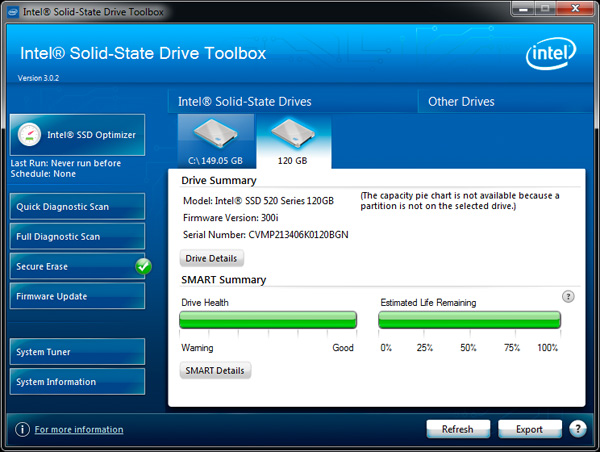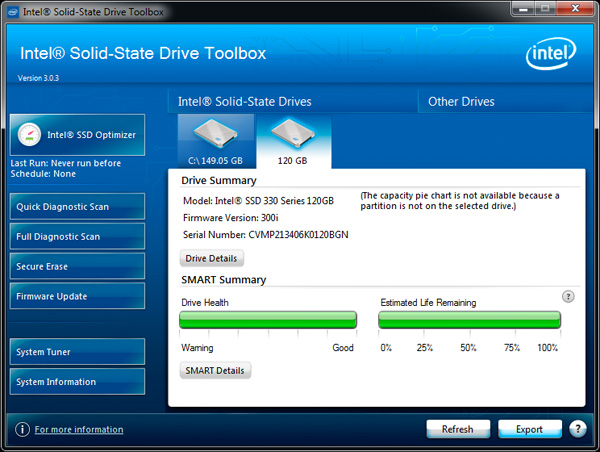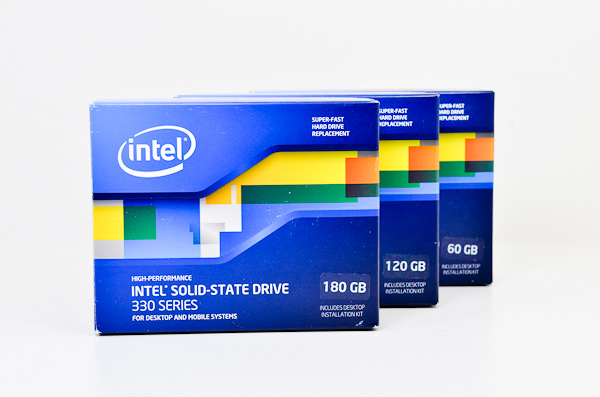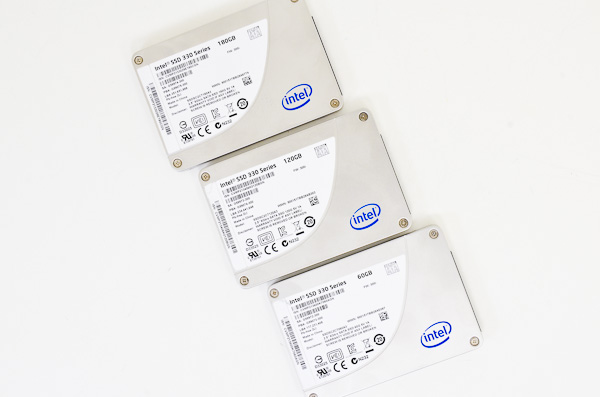The Intel SSD 330 Review (60GB, 120GB, 180GB)
by Anand Lal Shimpi on August 1, 2012 12:01 AM ESTEarlier this year Intel introduced its second SandForce based SSD: the Intel SSD 330. While Intel had previously reserved the 5xx line for 3rd party controllers, the 330 marks the first time Intel has used something other than its own branded controller in a mainstream or 3-series drive.
I don't doubt that I'll eventually get the story of how we got here. Apparently there's a good one behind why Intel's sequential write speed was capped at 100MB/s in the early days of the X25-M's controller. Regardless of how, this is where we are today: every new Intel SSD, with the exception of the high-end PCIe solution, is now powered by SandForce's SF-2281 controller and not Intel's own silicon.
The firmware is of course a collaboration between Intel and SandForce, although it's not clear if Intel ever had access to the firmware's source code or not. The result is a solution that performs a little differently than a standard SandForce drive, but should be less prone to compatibility/stability/reliability issues that have plagued SandForce drives for the past year. The latter is difficult to quantify.
We have seen examples of better behavior from Intel's SF-2281 firmware internally, and even wrote about one in our original Cherryville review. Despite Intel's best efforts, there are starting to be a small percentage of issues being reported in the wild. The number of publicly reported problems is very low, but it's impossible to say if this is a function of time or a truly superior design. I'm still comfortable in saying Intel's SandForce drives are good and likely better tested than any other SF drive, but as with any SSD, there can be issues depending on your system configuration. For what it's worth, even Intel's own controllers have had issues.
The Intel SSD 330
The 330 is available in four capacities: 60GB, 120GB, 180GB and 240GB. The limited launch capacities are a bit odd when you consider the Intel SSD 320 was available from 40GB all the way up to 600GB. Given the 330 uses the same controller as the 520, anyone who needs a larger drive can always buy the 520 instead.
Architecturally the 330 and 520 are identical. They both use the same SF-2281 6Gbps controller, and they both use Intel's 25nm MLC NAND. Actually, if you look at the 330's PCB itself you'll see the same layout as the 520 and Cherryville codename silkscreened onto the board. Despite the latter, Intel's SSD 330 is technically codenamed Maple Crest.
The similarities don't end there either. If you haven't updated to the latest Intel SSD Toolbox, the 330 is actually detected by the software as a 520:

Updating to the latest version rectifies the latter:

The 330 and 520 are very similar drives. The 330's primary differentiation comes from its use of cheaper, lower endurance MLC NAND. I'll get to the math behind why this isn't an issue at all for most users shortly. Conceptually, the 330 vs. the 520 is very similar to Kingston's HyperX 3K vs. regular HyperX drive. Just like with frequency binning for CPUs, there's endurance binning for NAND. Lower endurance parts are more plentiful (and thus cheaper) while the highest endurance parts will be sold for a premium (e.g. MLC-HET). If Intel does its job right, most of the stuff in the middle should be very good. And if it does its job really well, even the lower endurance parts should be more than good enough.
Intel's SSD 330 also carries a different firmware version from the 520: 300i vs. 400i. The firmware changes are likely minor in nature, however one major change is the loss of Intel's E2/E3/E4 SMART attributes for quick endurance testing. As I mentioned in our look at Intel SSDs in the enterprise, you can use these attributes to determine write amplification and estimate NAND longevity of a given workload. Intel views these as enterprise features, and with the 330's focus exclusively as a client drive it loses the features. You still have an accurate count of total host writes vs. NAND writes, as well as Intel's media wear indicator that lets you know what percentage of p/e cycles you have exhausted. I suspect this is more of Intel's famous forced segmentation at work rather than true delineation between client and datacenter drives. Depending on the server and workload, the 330 could be just fine.
Pricing
Using cheaper NAND allows Intel to be a little more aggressive on the 330's pricing without sacrificing margins. We turn to our Newegg pricing table once more to see where this puts the 330 in the grand scheme of things:
| SSD Price Comparison | |||||||
| Capacity | 60/64GB | 120/128GB | 180/192GB | 240/256GB | 480/512GB | ||
| Crucial m4 | $70 | $120 | $220 | $400 | |||
| Intel SSD 330 | $70 | $100 | $160 | ||||
| Intel SSD 520 | $90 | $125 | $190 | $255 | $500 | ||
| OCZ Vertex 3 | $70 | $95 | $200 | $530 | |||
| OCZ Vertex 4 | $75 | $115 | $210 | $550 | |||
| Plextor M3 | $160 | $270 | $575 | ||||
| Plextor M3 Pro | $180 | $280 | $680 | ||||
| Samsung SSD 830 | $128 | $143 | $282 | $700 | |||
Although SSD pricing is extremely volatile, Intel's SSD 330 tends to be among the cheaper solutions. The 60GB drive is just as cheap as the competition at $70, and the 120GB model is only $5 more than the chepaest alternative here. The 180GB drive is an interesting point below $200 if you need just a little more capacity than a 120GB drive would afford you. You pay a small price per GB penalty (~6%) but if you need capacity at a specific budget, it works. The newly announced 240GB drives were either backordered or not listed at many vendors.












64 Comments
View All Comments
Kristian Vättö - Thursday, August 2, 2012 - link
Check back tomorrow ;-)antef - Wednesday, August 1, 2012 - link
Buy buy buy! Even less than what Anand's chart show. What a deal.bim27142 - Wednesday, August 1, 2012 - link
I am really torn between Samsung 830 128GB and Intel 330 180GB...I am just a typical user and a casual gamer... I've read good reviews about Samsung's performance at since it's not Sandforce based...
Capacity-wise, I really find the Intel 180GB just right enough for me... So I am really torn which one is better for my case... :(
mailrachit - Monday, August 13, 2012 - link
As 'a typical user and casual gamer' myself I was asking the same question Samsung 830 128 GB or Intel 330 180 GB just two months ago when I was making a new ivy bridge desktop rig.I went with Intel 330 180 GB and I must say that I am quite happy with my decision.
The performance is stellar. I trust Intel for reliability and God knows I need the extra space (180 GB - 128 GB).
Look for deals and you can get the Intel one for real cheap (I got it for $110).
angelsmaster - Tuesday, September 4, 2012 - link
hi, i just also bought the 330 series but now, its 240 gb.. did you update the firmware,, cause i cant seem to find one for th 240gb. i know its the same as 180gb model. but i can't seem to make the link work. btw. iam using macbook pro 15" 2011. thank...SewerSoldier - Thursday, August 2, 2012 - link
Hi,I'm currently looking at buying a 120/128GB system/application SSD for use beside a 1TB HDD for media.
I'm deciding between Samsung 830 Series and Intel 330. However in my country the samsung costs 130€ and the intel 112€.
My question is if I'm right in assuming that Intel 330 is the better choice since the better performance of the samsung with incompressible data isn't really important for a system/application drive?
softdrinkviking - Friday, August 3, 2012 - link
disappointed that intel hasn't come back with a new controller of their own. I own and love a 34nm intel drive, and I love how reliable it has been.it seems like intel can really put out good stuff when they put enough R&D into it, but I am not sure about their track record when working with other companies on tech. (like sandforce)
Per Hansson - Saturday, August 4, 2012 - link
Well honestly there have been reports of the "8MB bug" happening even with the latest firmware on the Intel 320 drive so I would not be so sure about that...http://communities.intel.com/thread/24339
http://communities.intel.com/message/162330
http://communities.intel.com/message/161880
softdrinkviking - Saturday, August 4, 2012 - link
Oh yeah, I forgot about that whole fiasco. Still, there is something I don't like about relying on data compression technology to speed up a drive. The potential for catastrophic data loss seems to be higher if you are dealing with multiple levels of logic abstraction. For similar reasons, I never used those drive doubler technologies that were popular before traditional HDDs became so big.Thinking about it from a data recovery point of view, how would this effect the difficulty and cost of recovering data from a drive?
I know the whole recovery process would be totally different from a HDD, but it still could be a consideration.
booomups - Thursday, August 30, 2012 - link
i really wonder about this, since it seems strange if intel says on some drives it does and in others it doesn make sense. in the review it says its enabled for the 180gb version, and not for the 120gb version. how certain is that even in newer drives revisions?and... intel doesnt mention e aes encryption for the 330 drives, but it is a big point for the 520 drives.
any details on that, ita the same chip after all.